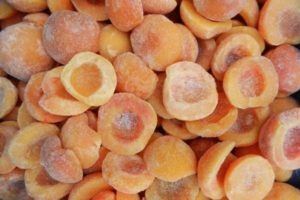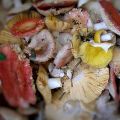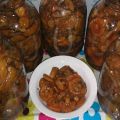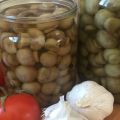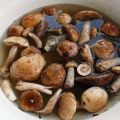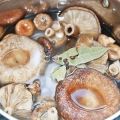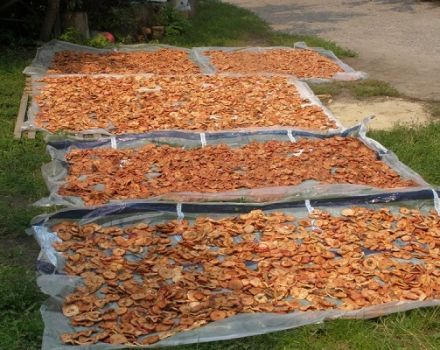TOP 10 recipes on how to freeze mushrooms for the winter at home in the refrigerator, shelf life
Mushrooms in dishes are mainly observed in summer and autumn - everything is explained by the season. But there are ways to preserve the product and all the beneficial trace elements for a long time - to freeze them. Further, the features of how to freeze raw mushrooms or already cooked will be discussed in detail.
Content
- 1 Why freeze mushrooms
- 2 Advantages and Disadvantages of Freezing
- 3 Mushrooms suitable for freezing
- 4 How to choose and prepare mushrooms correctly
- 5 Cookware required for freezing
- 6 Preparing the refrigerator
- 7 Freezing methods at home
- 8 What temperature is required for freezing
- 9 Terms and rules for storing frozen food
- 10 How to properly defrost mushrooms
Why freeze mushrooms
The best way to preserve the nutrients and value of a product is to freeze it. Unlike other blanks, mushrooms will not lose their shape, color, texture, vitamins and trace elements in the composition. The method also has a positive effect on the mood of the hostess - for harvesting, it is enough just to clean the caps, if the type of mushroom requires it, and place them in a container.
Advantages and Disadvantages of Freezing
Often, professional chefs use frozen mushrooms because they know all the benefits of harvesting. The positive factors include the following points:
- Minimum time to prepare the product - as already described above, the mushrooms are simply cleaned of contamination and placed in the freezer. You can first boil or stew the workpiece, then after defrosting, less time will be spent on cooking.
- Freezing is a surefire way to preserve all the benefits of a product.
- A frozen workpiece is allowed to be stored for up to a year - then it is better to get rid of the product, since it, after defrosting, will lose its texture.
- Once thawed, raw mushrooms can be cooked straight away - you don't have to soak them for quicker cooking.
- The mushroom taste will be preserved when frozen, both in the raw product and in the finished semi-finished product.
- The thawed product can then be salted or pickled.
The disadvantage lies in the peculiarities of storing the product in frozen form. It is important to observe the temperature regime here, since deviations from the norm will lead to a loss of appearance and taste..
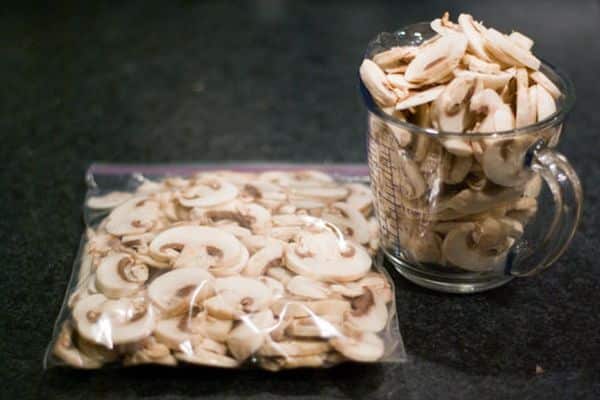
Mushrooms suitable for freezing
It is recommended to freeze mushrooms that best of all retain their taste and beneficial substances. These include the following varieties:
- chanterelles;
- honey mushrooms;
- aspen mushrooms;
- champignons;
- boletus.
If they are not there, then you can take the second most popular varieties, which almost retain their taste characteristics:
- waves;
- russula;
- White mushrooms;
- boletus;
- mushrooms;
- oyster mushrooms.
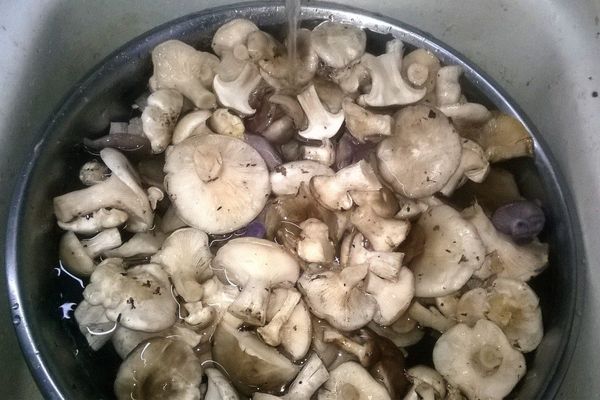
To a greater extent, one should pay attention not to the variety and taste, but to observe the rules of freezing and subsequent storage.
How to choose and prepare mushrooms correctly
The following factors should be attributed to the rules for choosing and preparing a product for freezing:
- it is better to pick mushrooms in the forest, but if this is not possible, they purchase the product fresh in the supermarket;
- often in the store you can buy fresh oyster mushrooms and mushrooms - when choosing, they pay attention to the absence of painful points (these are traces of worms), the product should not be wilted;
- mushrooms are cleaned before freezing - they remove all the garbage and the top film from the cap (if it is required), then the whole mass is washed under running water;
- after washing, give time to dry the workpiece on a towel - it is not recommended to freeze the product with water;
- if there is a desire to freeze already cooked mushrooms, it is necessary to subject them to heat treatment within 24 hours after collection.
These are the basic steps in preparing food for freezing. It is important to remove all wormy specimens, for which large ones are cut into several parts.
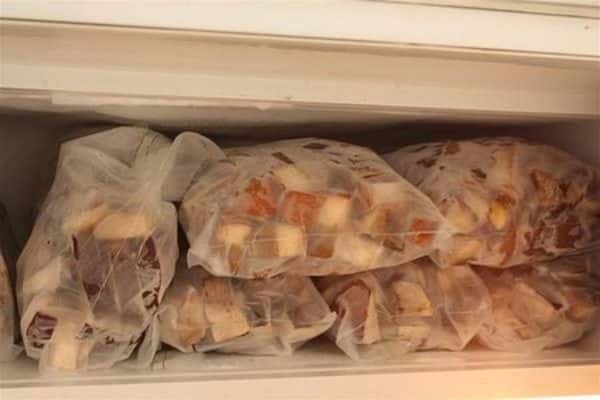
Cookware required for freezing
It is recommended to freeze mushrooms in closed plastic containers. When laying out, fold the food as tightly as possible to remove air from the dishes.
If there are no containers, you can use bags (special vacuum ones, for freezing, or simple ones) - they also remove, if possible, all the air from them. It should be understood that the product may lose shape when stored in bags. Storage will not affect the appearance if the workpiece is crushed.
If the freezing will take place in bags, it is better to first lay out the product on a tray and place it in the freezer. After the mushrooms are frozen, you can put them in a bag - this way you will be able to freeze the mushrooms without losing their appearance and shape.
Preparing the refrigerator
The product is frozen in a freezer, which is pre-cleared of ice on the walls and door. If storage takes place in a container, it is sufficient to place it horizontally in the chamber on any shelf. If packaged in bags, they are placed on a separate shelf, laying out the workpiece in one layer.
Freezing methods at home
Mushrooms can be frozen fresh, boiled and even with broth. The type of product in the future will partially determine the method of their preparation, therefore, before making a decision, you should choose the most correct one.
Raw mushrooms
Among those frozen in the supermarket, you can find only raw semi-finished products. Such a blank is easy to make at home, following the following sequence of actions:

- Prepare the product for freezing.
- Place on a tray in one layer and place in the freezer. If using a container, pack the workpiece tightly and also put it in the freezer.
- Set the freezer to the lowest temperature for 12 hours of freezing.
- After that, the temperature is reduced to the required indicator and everything is distributed in the bags.
It is recommended to set the maximum temperature when collecting the product in the forest. It is important to consider the presence of dense texture and large size.
Salty
Freezing of salted mushrooms is possible, which is often chosen to preserve an open can of the product. This requires the following actions:

- Drain the contents of the jar in a colander.
- Rinse under running water while removing peppercorns, if present, and other additives.
- Dry in a standard way - spreading them out on a towel.
- The dried product must be frozen using any of the above methods.
Further, after defrosting, the workpiece will have a characteristic salty taste.It will be enough to add onions, vinegar or vegetable oil to them to resume the original dish.
Boiled
Boiled After defrosting, mushrooms are faster to cook, so housewives prefer to do preliminary preparation. It is also recommended to use the actions presented in the case when the appearance of the product is somewhat spoiled - there are broken caps or damage obtained during cleaning.
To properly freeze the boiled product, it is recommended to do the following:
- Put a saucepan on the fire at the rate of 5 liters of water per 1 kilogram of product. The water can be salted, or you can refuse it, depending on your taste preferences.
- The workpiece can be put into the water in advance, without waiting for the water to boil.
- Boiling mushrooms until fully cooked, housewives are faced in the future with the dryness of the product in the finished dish. It is enough to boil for 5-10 minutes.
- Next, remove all the mushrooms with a slotted spoon and let them dry.
You can freeze without preliminary drying, but then it is better to use containers for this.
Blanched
Frozen blanched blanks are great for further soup preparation. They will retain their shape, color, taste and useful trace elements; with the help of pre-treatment, you can completely clean the mushrooms from dirt.

To freeze pre-blanched blanks, you will need to do the following:
- Prepare a pot of water with the required amount.
- Wait until it boils, pour the prepared product into water and wait for it to boil again.
- Then boil for 2 minutes.
- Turn off the heat and drain the contents of the pot into a colander.
- Wait until the water is completely drained and put the workpiece into containers for freezing and storage.
Mushrooms can be blanched whole or in their chopped form. The water can be slightly salted, but not overdone, so that during the subsequent preparation of the dish, the product does not turn out to be oversalted.
Stewed
Stews are preferable to eat right away, but some housewives prefer to prepare healthy bags for the winter in order to shorten the preparation time of the main course. Stew is required in compliance with the basic recommendations that will help preserve the original appearance and taste of the product:
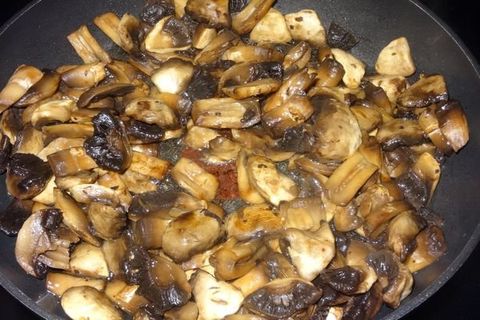
- The workpiece is cleaned of dirt and soaked in a citric acid solution - a teaspoon of citric acid in powder form is added to a liter of water. The product is kept in solution for no more than 7 minutes.
- At this time, the pan is heated, where you should pour a little vegetable oil.
- Put the workpiece in a preheated pan and simmer for 4-5 minutes, stirring constantly. Onions can be added for better flavor. Stew with open onions for 2-3 minutes.
- Next, cover the pan with a lid and stew for 20 minutes, season with salt and pepper the mushrooms.
- After the time has elapsed, the fire is turned off and left to infuse and cool completely.
If you plan to use the mushrooms for cooking various dishes, it is recommended to drain the oil and the resulting juice. Otherwise, freeze as received and use the preparation for sauces.
Fried
It turns out an excellent workpiece from fried mushrooms, but they are not cooked in a pan, so that they do not dry out during subsequent heat treatment. For frying, they are crushed - it is better to do this in thin layers. You need to pour a little oil into the pan and heat it, place several pieces of mushrooms on the surface of the dishes in one layer.

It is enough to fry thin and small layers for 4-5 minutes, larger ones - up to 10 minutes. Then everything is cooled and placed in freezer containers.
Mushrooms with broth
Here they use broth from cooking the product.For freezing, containers are used, in which packages are placed in such a way that the edges will cover the sides of the container used. Mushrooms are poured into them along with broth.
The workpiece is put into the freezer before freezing. Then the package is taken out and stored without a container throughout the winter. Use frozen convenience foods with broth to make soup.
What temperature is required for freezing
Storing mushrooms in the freezer means controlling the temperature at -18 degrees. This is the only way to fully preserve the appearance of the product and its useful properties.
Terms and rules for storing frozen food
To prevent mushrooms from losing their original appearance and texture, it is recommended to follow the following storage guidelines:
- the shelf life is not limited, but mushrooms should not be kept in the freezer for more than a year - they lose their taste;
- should be stored separately from meat products and semi-finished products - if this is not possible, then the mushrooms are tightly wrapped in a bag;
- Do not thaw frozen pouches and then re-freeze - this will lead to a loss of texture, the product will become slimy and tasteless.

It is required to store in a working freezer that will keep a constant temperature of -18 * -19 degrees.
How to properly defrost mushrooms
To defrost the product without losing its taste, the following recommendations must be observed:
- it is better to defrost in the refrigerator;
- from the freezer, transfer the workpiece to the refrigerator overnight, after placing it in a container or plate;
- you can, without defrosting the workpiece, add it to a saucepan with soup or to a frying pan;
- you cannot use a cup of water for defrosting - this will lead to excessive ingress of moisture, which will cause the taste to be lost;
- you can place the used blank bag in water for defrosting, but only so that moisture does not get inside.
Freezing and storing mushrooms is not difficult if you follow all the rules and recommendations. It is important to determine exactly the method of preliminary preparation, which is influenced, first of all, by the type of product and options for subsequent preparation.

